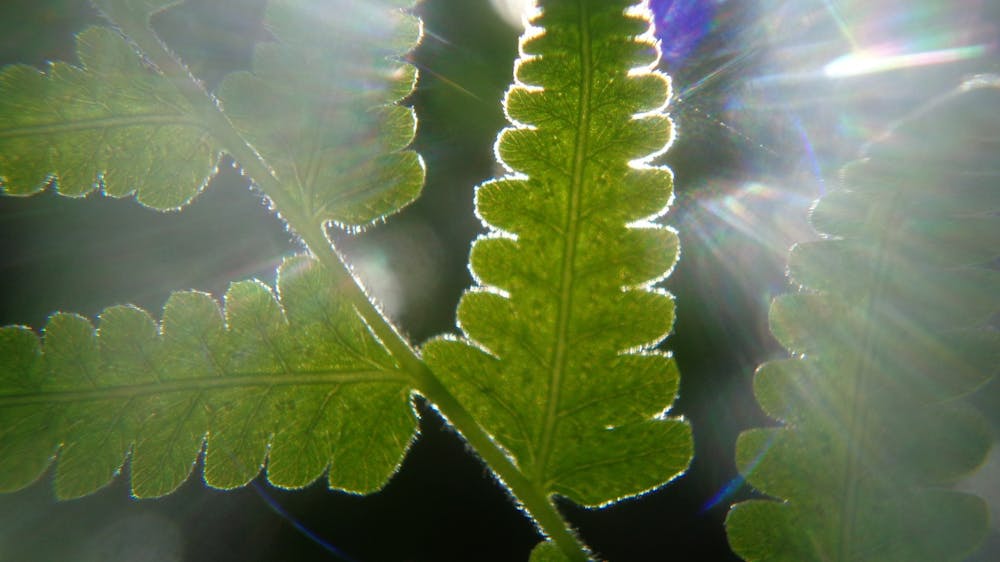The chemistry of how plants absorb light on a sunny day is more complicated than you may have realized.
Those chemical mechanisms were the topic of Alexander Ayzner’s talk titled “Scrambled Eggs and Ladders: Understanding Formation and Exciton Transport of Aqueous inter-Conjugated Polyelectrolyte Complexes,” for the Ephraim and Wilma Shaw Rosemen Colloquium Series at Hopkins.
Ayzner, assistant professor of Chemistry and Biochemistry at the University of California Santa Cruz, discussed the complexity of light-harvesting supersystems, like chlorophyll used in photosynthesis in plants, and noted the challenges of engineering all of the components of such supersystems.
He began by describing the overall process of how concentrated masses of energy, called excitons, search for reaction centers in chlorophyll.
Antenna pigments, which harness light energy similar to how television antennae pick up radio signals, are critical to the process. An example is of such a pigment is carotene, which gives carrots their orange color.
The excitons move via a process called electronic energy transfer (EET). EET is mediated through a resonance interaction between the excited state donor and acceptor — an interaction that occurs in less than 250 femtoseconds.
“As the donor gets excited, the acceptor gets excited in a simultaneous process,” he said in his presentation.
In the process that he studied, a molecule called CPE PFPI was the donor and the acceptor was CPE re-PTAK. Ayzner described the energy transfer between those two molecules, and other forms of energy transfer in general, as the primary theme of his research.
While he noted the alluring promise of molecular light-harvesting, Ayzner concedes that there are still substantial efforts to produce an assembly that rapidly transports excitons and minimizes other confounding factors.
“We are still at a moment far away from [creating] a complex light-harvesting system that one finds in nature,” he said.
In particular, he aims to assemble supramolecular light-harvesting antenna using conjugated polyelectrolytes, which are a class of organic semiconductors that are highly soluble in water.
Ayzner further discussed conjugated polyelectrolytes as primary light harvesters, describing these polymers as not infinitesimally stretched, but rather as extended regions consisting of an ensemble of chromophores that are coupled to each other.
He also highlighted the electron delocalization of polymers in a chain, stating that the fluctuations across the chain influence the complexes formed with each other.
He described how this particular polymer folds in on itself leading to pi-pi stacking interactions, which are attractive interactions between aromatic rings in a molecule.
This is attributed to the formation of a collapsed “scrambled egg,” hinting at a possible clarification of the talk’s distinct title. The “ladders” refers to the extended ladder-like complexes that PTAK forms in the presence of an excess positive charge.
Ayzner also discussed the processes of unfolding those polymers, arguing that these processes appear to be a cooperative process occurring in a network rather than a singular complex.
In an interview with The News-Letter following his talk, Ayzner described how his early interest in polymer chemistry contributed to his current research focus.
“I took polymer chemistry my senior year and did a special project conducting polymers and found that very fascinating. I wanted to learn about sequential electron transfer,” Ayzner said.
Ayzner also mentioned the significance of developing models which represent the thermodynamic processes that characterize the formation of PFPI/rePTAK complexes. Understanding processes such as the changes in enthalpy and corresponding magnitudes, is of particular interest to him in his career as a physical chemist.
Ayzner further described the presence of hierarchical light-harvesting systems. Excitons are funneled from outside the molecule toward the membrane interior and different chemical regions compartmentalize the various internal structures.
Toward the end of his talk, Ayzner raised the possibility of mimicking some of the critical aspects of light-harvesting organelles. He described the complexity of light-harvesting as daunting, but believes some steps can be imitated. He anticipates that scientists will continue to investigate the implications of light-harvest systems and the practicality of recreating such a system.
“I would like to keep pushing on this idea of a light-harvest organelle mimic to some extent. I think it is intellectually fascinating to recreate some of these basic functions that we find in natural systems,” he said in an interview with The News-Letter. “It is certainly very daunting that it is clear that it may not work, but I think that is motivating in a sense.”





